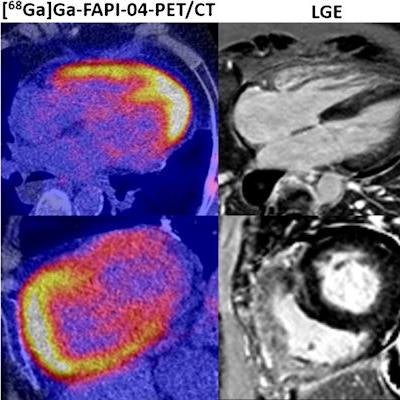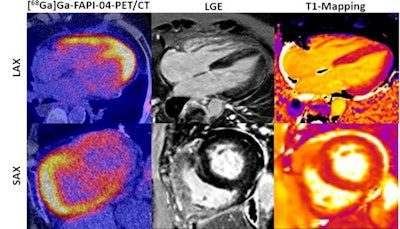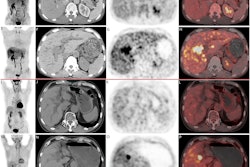
PET imaging with a fibroblast activation protein inhibitor (FAPI) radiotracer can visualize myocardial fibrosis (MF) on the molecular level and could be a new diagnostic option for monitoring patients, according to a German group.
In a proof-of-concept study, researchers at University of Erlangen-Nuremberg tested whether gallium-68 (Ga-68) FAPI-04 tracer uptake could differentiate scleroderma patients with myocardial fibrosis from those without myocardial fibrosis. They observed consistent Ga-68 FAPI-04 uptake and suggested the approach could improve early assessment of treatment responses.
"We present first in-human evidence that Ga-68 FAPI-04 uptake visualizes fibroblast activation in [systemic sclerosis]-related MF and may be a diagnostic option to monitor cardiac fibroblast activity in situ," wrote corresponding author Dr. Christina Bergmann. The study was published online December 16 in the European Journal of Nuclear Medicine and Molecular Imaging.
MF is a major factor in deaths related to scleroderma, a prototypical fibrosing disorder with high case-related mortality. In MF, fibroblast cells accumulate in vascular tissue and can eventually disrupt the ability of heart muscle to contract. The process is partly regulated by fibroblast activation protein (FAP) on the surface of the cells.
 Increased Ga-68 FAPI-04 uptake corresponds to the accumulation of FAP+-expressing myofibroblasts in myocardial biopsy. Representative image of a Ga-68 FAPI-04-PET/CT scan and the corresponding image of cardiac MRI with late gadolinium enhancement (LGE) and T1-mapping of a patient with myocardial fibrosis (MF). Image courtesy of the European Journal of Nuclear Medicine and Molecular Imaging though CC BY 4.0 International License.
Increased Ga-68 FAPI-04 uptake corresponds to the accumulation of FAP+-expressing myofibroblasts in myocardial biopsy. Representative image of a Ga-68 FAPI-04-PET/CT scan and the corresponding image of cardiac MRI with late gadolinium enhancement (LGE) and T1-mapping of a patient with myocardial fibrosis (MF). Image courtesy of the European Journal of Nuclear Medicine and Molecular Imaging though CC BY 4.0 International License.Although cardiac MRI is considered the gold standard for noninvasive diagnostics of MF, the modality predominately monitors the accrual of fibrotic tissue damage, rather than the activity of the fibrotic remodeling process, the authors wrote.
Thus, with experimental FAPI-PET radiotracers such as Ga-68 FAPI-04 showing promise visualizing fibroblast activation in cancer patients, the researchers hypothesized that tracer uptake could reveal molecular fibroblast activity in these patients.
The study authors evaluated imaging from six scleroderma patients with and eight without MF who underwent Ga-68 FAPI-04-PET/CT, cardiac MRI, and clinical and serologic lab tests at their hospital in Erlangen between January 2020 and December 2020.
Results showed that Ga-68 FAPI-04 tracer uptake was increased in scleroderma patients with MF, with higher uptake in patients with arrhythmias, elevated serum markers for myocardial dysfunction, and MRI-positive regions. Myocardial biopsies from Ga-68 FAPI-04-positive regions confirmed the accumulation of fibroblasts expressing FAP, they found.
In addition, the researchers studied sequential Ga-68 FAPI-04-PET/CTs and observed dynamic changes of tracer uptake were associated with changes in the activity of scleroderma-related MF, while cMRI parameters rather indicated only tissue damage.
"We observed that changes of Ga-68 FAPI-04 uptake between baseline and follow-up paralleled the changes of clinical parameters," Bergmann and colleagues wrote.
Ultimately, the study was small, and further research is planned, according to the authors.
"The analysis of the potential prognostic role of myocardial Ga-68 FAPI-04 uptake for the course of myocardial fibrosis will be subject of larger multicenter studies," the group concluded.




















